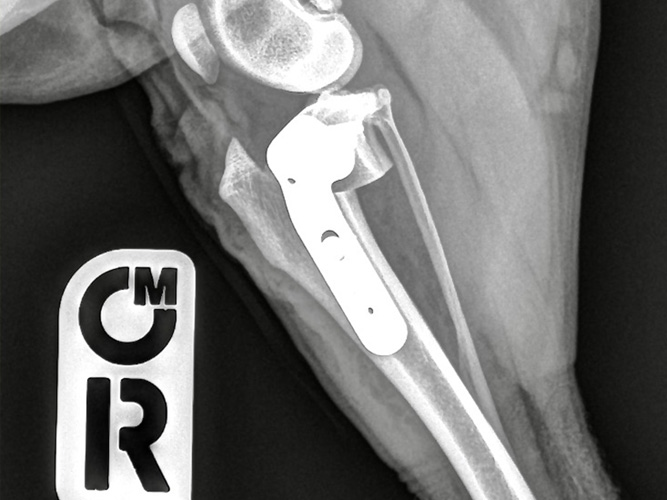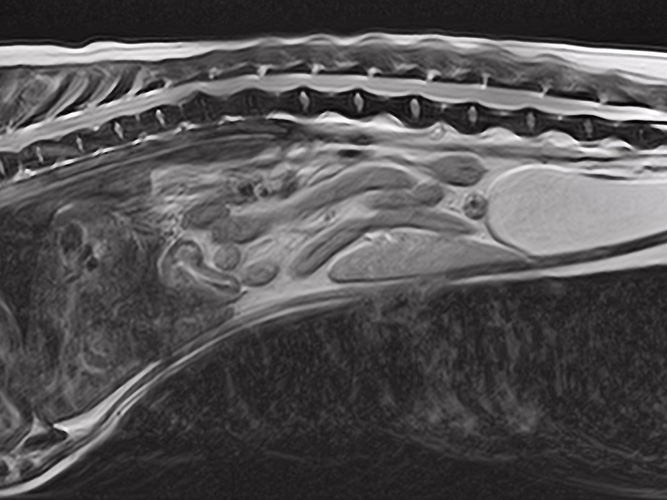Ted's Tricky FissureShare on
Dogwood’s Case Digest:
- Humeral Intracondylar Fissure (HIF) is a stress fracture in the elbow
- HIF is common in Springer Spaniels and Cocker Spaniels
- HIF can lead to elbow pain and severe elbow fractures
- Surgery most commonly involves placing a large screw across the fissure
- Patient-specific guides help accuracy of surgery
- Long-term prognosis is excellent
When Ted was referred to Dogwood Referrals, being a middle-aged Springer Spaniel, the experienced surgeons had a good idea what was going on. Ted’s owners had noticed an intermittent left forelimb lameness which seemed to improve and then deteriorate without an obvious cause. Ted’s owners took him to their vet who localised pain to the left elbow. Ted’s owners then referred him to Dogwood Referrals for advanced imaging and their specialist orthopaedic skill-set.
|
Ted at Dogwood Referrals |
An advanced CT scan was performed which gives intricate detail of the bones of the elbow and confirmed our suspicions; Ted had a Humeral Intracondylar Fissure or HIF. This is a gap or fissure in one of the bones of the elbow which acts as a weak point. When walking or running the fissure moves causing inflammation, pain and has around a 20% chance of causing a catastrophic fracture.
|
CT scan performed at Dogwood Referrals showing the HIF in his elbow |
There is a lot of research on HIF in veterinary medicine but we still don’t have all the answers. What we do know is they are commonly seen in Springer Spaniels and Cocker Spaniels, and have also been diagnosed in Labradors and German Shepherd Dogs (GSDs). They are likely to be a stress fracture of the elbow. The exact cause is still controversial. There is a lot of research currently ongoing around similarities to French Bulldog elbow fractures but this is likely to be a different issue to HIF seen in Spaniels.
Fractures associated with HIF can be extremely challenging to manage. In our experience, HIF affected patients tend to present in three different ways:
- A patient completely unaffected by the HIF, which is found incidentally on CT whilst investigating something else.
- A patient who has intermittent signs of limping.
- A patient with a severe elbow fracture who was limping for a few weeks before.
Our belief is that a patient showing elbow pain is a very good candidate for surgery to stop the fissure getting worse. Most surgery for HIF involves placing a large screw across the bone to stop the fissure moving and prevent catastrophic fracture. However, as with any surgery there are risks, with a consistent concern being post-operative infection.
We discussed all the options with Ted’s owners who were keen to continue with stabilising Ted’s HIF. We collaborated with our friends at Fusion Implants who used our CT scan to produce a Ted-specific guide to help place the screw as accurately as possible.
|
Surgical guide produced specific for Ted's elbow |
The guide was sent to Dogwood Referrals within a few days and was used to place a large screw across Ted’s elbow. Surgery went very well and X-rays showed a great screw position.
|
Post-op Xrays showing the large screw used to stabilise the HIF |
Ted spent the night under the care of the professionals at Dogwood Referrals recuperating from his anaesthetic before being discharged the following day. So far Ted has shown an excellent recovery and we will keep in touch with his owners over the coming months to ensure a smooth rehabilitation so that Ted can get back to doing what Springer’s do best!
-
Previous
-
Next




